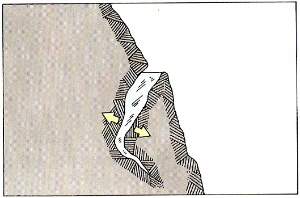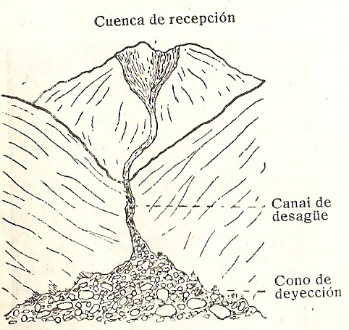
Erosion |

Name: ______________________________________ Subject: _______________________ Date: _______
Write on the right side what is missing.
1. The erosion
It is the constantly wearing away that the earth’s surface suffers when it is attacked by wind, water, streams, groundwater, glaciers and oceans.
In the picture, we see how the hard rocks remain while the soft rocks have disappeared. The river water also causes erosion on the earth's surface.

2. The wind
The wind itself can not wear away the rocks, but when it transports solid particles of sand or dust in suspension, it produces continuous erosion. It will be stronger if the wind speed and the number and size of particles that it transports is greater.
In the picture, we see how the wind, sweeping along bits of sand and other bodies, erodes a rock that has the form of a mushroom.
3. Answer if these sentences are true or false:
The wind itself produces erosion |
|
Strong wind with sand causes erosion |
|
Weak wind causes erosion |
|
The more speed, the more erosion |
4. The rainwater
Rainwater forms multiple small streams that sweep along loose and disintegrating materials, wearing down the rocks and producing grooves and small ravines. If the rocks are soluble, such as limestone, the land is covered by a network of irregular channels separated by crests that make it impassable.
 |
 |
In the high mountains, rock crevices fill with water, which turns into ice because of the cold. This acts as a wedge, resulting in the breaking of rocks. It is what we see in the upper picture.
5. Are these statements true or false?
The rainwater forms small streams |
|
The stream does not sweep along materials |
|
The water dissolves the limestone |
|
The Ice increases in volume |
|
The ice does not break the rocks |

6. Streams and rivers
The rainwater or the water from snowmelt form trickles of water in the mountains of high slope without vegetation. When these trickles of water are in a higher stream bed, they originate streams.
Streams are not continuous water currents that pass through valleys of steep slopes. We can distinguish three areas:
- Reception basin: the water runs with great speed, sweeping along rocks and boulders and causing erosion on slopes.
- Drainage basin: the water transports the removed materials. They produce the stream bed erosion.
- Alluvial fan: the water loses velocity when it arrives to the lower area and materials are deposited in the valley forming a broad triangle.
In the picture, we see the three parts of the stream. The rivers with more volume of flow than streams produce similar erosion.
Glaciers are huge masses of ice which skate slowly into the mountains, sweeping along rocks and other materials.
7. Indicate the part of the torrent: reception basin, drainage basin or alluvial fan:
Flooring materials are sweeping along |
|
Materials are deposited in the valley |
|
Materials are transported |
8. Groundwater
Part of the rainwater finds sandy areas, which are permeable. It strains to be retained by clay impermeable layers. Thus, aquifers or water pocket are formed in the subsoil. Hence springs and hot springs emerge, and if they are drilled, ordinary and artesian aquifers arise.

When water with carbon dioxide strains, it dissolves salts, rocks, etc. This contributes to the formation of grottos, caves and caverns. When Waters that have dissolved limestone rocks strain in the caves, they form
stalactites on the roof and stalagmites on the floor. This process is very slow and takes many years to produce artistic forms.
In the picture, we see the inside of a gallery with stalactites and stalagmites.
9. Answer if these sentences refer to aquifers, stalactites or stalagmites:
Columns are based on the roof are called |
|
The water pocket in the subsoil is a |
|
Columns are based on the floor are called |

10. Coastal erosion
The main cause of coastal erosion is waves. When the waves crash with the cliffs, they undermine their base and cause the fall of the upper part, moving them back. The collapsed blocks are destroyed and reduced to pebbles, sand and mud. In the picture, we can see this phenomenon.
11. Indicate if these sentences are true or false:
The waves cause coastal erosion |
|
The waves collide with the beach |
|
Pebbles and sand are created |
| Educational applications |
Natural sciences |
In Spanish |
Interactive
®Arturo Ramo García.-Record of intellectual property of Teruel (Spain)
No 141, of 29-IX-1999
Plaza Playa de Aro, 3, 1º DO 44002-TERUEL